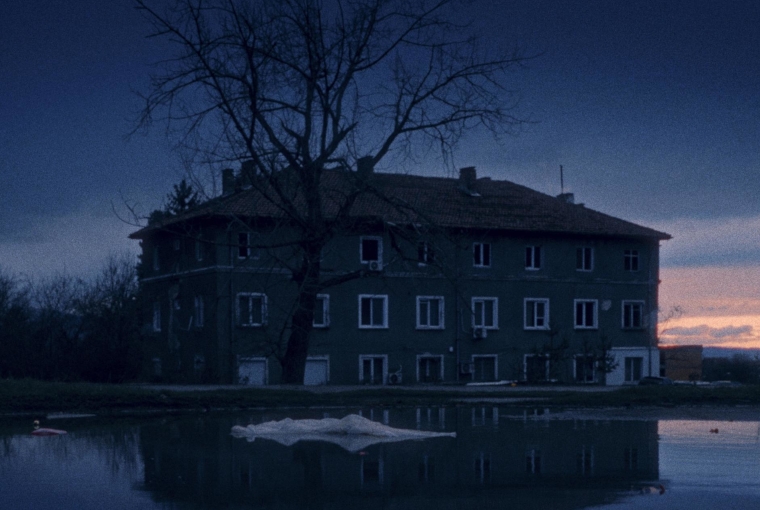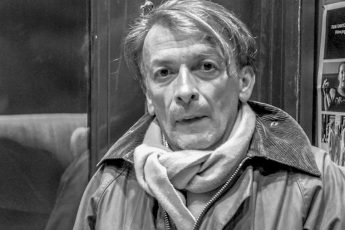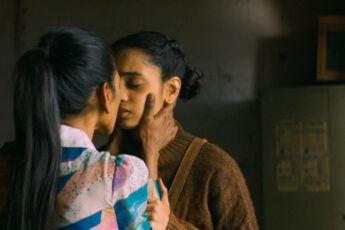“I Don’t Want to Be Put in a Plastic Bag.”
Pavel Vesnakov’s Windless (Bezvetrije, 2024)
Vol. 151 (January 2025) by Jack Page
The seemingly innocent homecoming of a young man burying his estranged father quickly escalates into something more sinister and soul-searching. The city’s mayor plans to build a casino resort upon the local cemetery, leading to the unceremonious relocation of the dead. Homecomer Kaloyan is enlisted to help an old acquaintance empty out what’s left of the village’s remaining apartment blocks. By so doing, he will encounter a number of residents that knew his father and these interactions will thrust him into a ruminative state, one that will make him question his attitude towards his own past and to his father.
Windless is a dramatic adaptation on bereavement that also encapsulates related themes of losing oneself and the place one comes from. Triggered by his return home, Kaloyan is forced to come to terms with not just the loss of a parent, but also his childhood trauma. The deterioration of his past is quite literally manifested in the film’s visuals, where the setting of Kaloyan’s hometown is in pieces. He aggressively dismantles and burns discarded furniture in each flat until entire spaces are nothing but crackling black objects, their embers and flames licking the night sky. The village is mostly deserted, its buildings dilapidated. The street’s worn, skeletal architecture is stripped bare and every room is hollowed out, vanishing like a faded memory. After over eight years in Spain, Kaloyan’s ties to Bulgaria seem to have withered. When he attempts to reconnect with his roots – in the hope of expounding a posthumous closeness with his father – he comes to regret his decision. A realization leaves him in a depressed spirit. He is neither here nor there. That is to say, he is treated like an immigrant in Spain for not being a true citizen and his own country is disappearing in front of his very eyes. His sense of longing to belong is yet another seemingly oxymoronic tact that can be seen pushing and pulling Kaloyan as he initially rejects and later accepts that his identity is in jeopardy. All of this character introspection is done within a lean ninety-minute runtime and with minimal artistic flourish. Every frame and every scene is trimmed so perfectly that the director is able to do so much with so little.
Kaloyan – played by nefarious Bulgarian rapper Fyre – has a fierce presence on-screen. His shaved head exposes a wiry skull covered in face tattoos. Dressed in a red Adidas tracksuit, he silently smokes his cigarettes in the early morning light. Framed in a tight, medium close-up shot, his image is hidden, entirely out of focus. Only truck sounds and the distant background of headlights illuminating the trees suggest an undisclosed location on the roadside. Tires screech to a halt with the hiss of the pistons and a broken voice mumbles over a tannoy, drowned out by the piercing twitter of birds. Even in this opening scene Kaloyan is alone, displaced and mystified by the camera’s focus. A menacing soundtrack plays over the title sequence. It can only be described as the plucking of reverberating strings, punctuated by an aggressive, singular strum of an electric steel guitar. The rhythm of the beat matches Kaloyan’s melancholic aura, both brooding and masculine but also timorous. As the audience will witness, these indecisive notes and discordant melody will serenade the protagonist as he too faces insecurity and doubt. Importantly, the music highlights the film’s motif of disconnectedness in a way that compliments the similarly isolating aesthetic and therefore Kaloyan’s own sense of disassociation.
The film’s cinematography is strictly photojournalistic. Characters are framed by a static camera in medium-sized portraits for extended takes, employing a square 1:1 aspect ratio. The duration of the shot always lingers, even when figures have left the frame. The camera also refuses to follow any action. Some conversations are had without any shot-reverse-shot techniques, with the cinematographer Orlin Ruevski going so far as to have the camera aimed at the back of heads throughout the entire dialogue. There are few deep focus establishing shots of exteriors. The camera instead focuses on domestic settings such as cramped dinner tables and childhood bedrooms. The monologues of the local townsfolk who regale Kaloyan with stories of his father’s antics are shot in an interview style. It gives the film an unwavering intimacy and intensity that forces the spectator to observe these awkwardly emotional memories they want to share. It’s simultaneously endearing and claustrophobic as they smother Kaloyan with unprovoked life advice and forgotten secrets, their unflinching, watery eyes staring straight into the lens. One striking example of the camera’s disinterest in the film’s narrative can be seen when Kaloyan talks to his friend about UFOs. As he recollects his childhood up front in the driver’s seat of the truck, the camera peeks out a loose flap in the cargo hold and watches the snowy estates blur by outside. The next shot is buried amongst the items strewn in the back of the truck as they continue their discussion. The partition between the front and back of the vehicle greys out the men’s outlines to look like shadows. In this way, the omnipresent camera allows the audience to observe as if they are just a restless third party sitting in the back of the truck, peeking out of the untied tarpaulin that covers the cargo bed. Ironically, although the camera ignores the direction of the conversation, it does not distract from it, allowing the spectator to focus on the dialogue because of the unremarkable, pedestrian scenes captured by the lens in these moments.
Windless is ultimately a very enigmatic feature and it is unknown whether Kaloyan has had a life-changing epiphany by the film’s close. One reading is that the time spent with his father’s friends and family has stirred some unresolved childhood trauma and shifted Kaloyan’s priorities. In refusing to sell his father’s house and collect his remains, perhaps these are the first steps in dealing with his difficult relationship with his father. Similarly, the ceremonious nature of the village’s demolition could be interpreted as a kind of cremation of his younger self and a metaphorical letting go of the past.




Leave a Comment